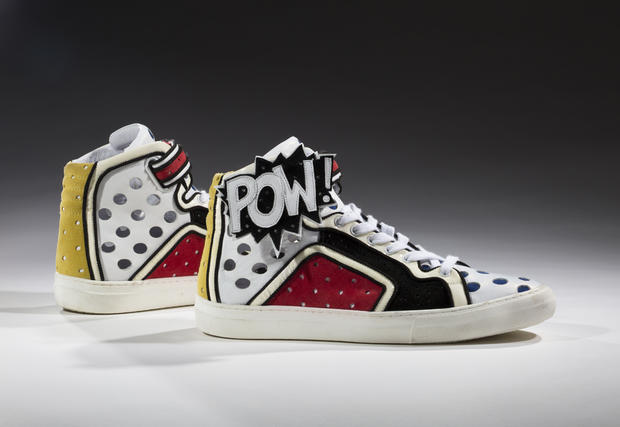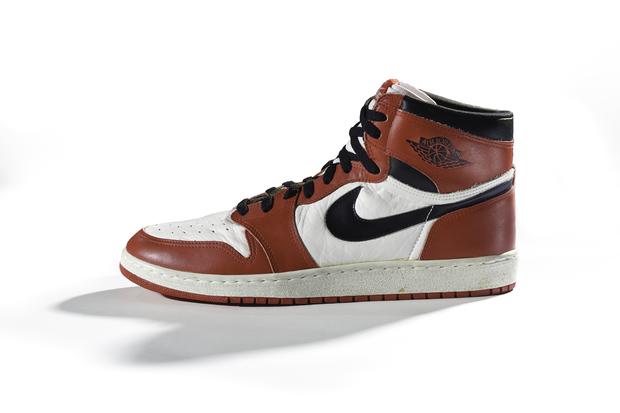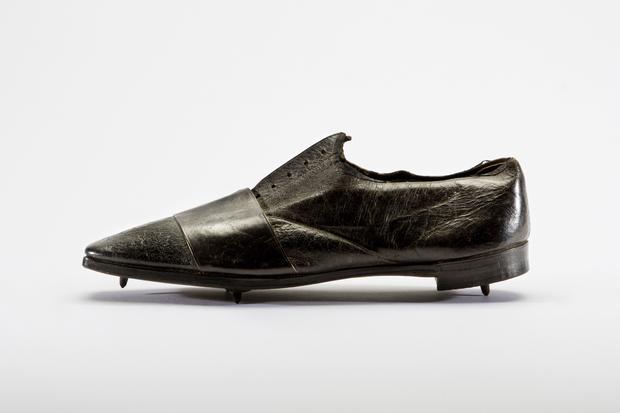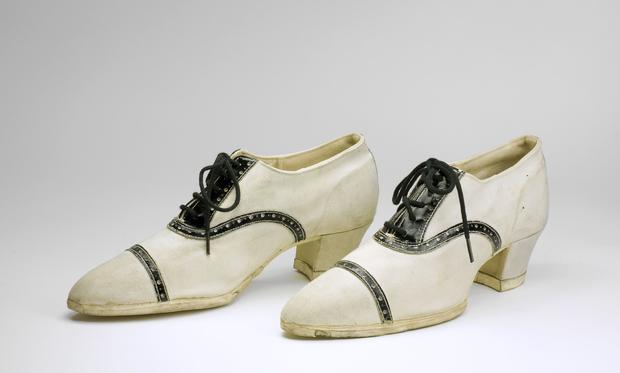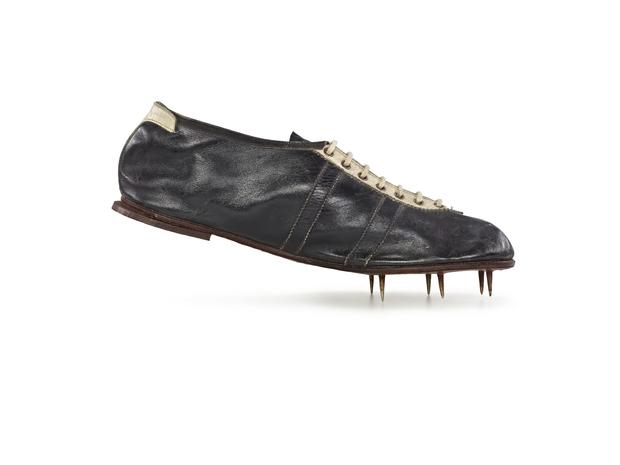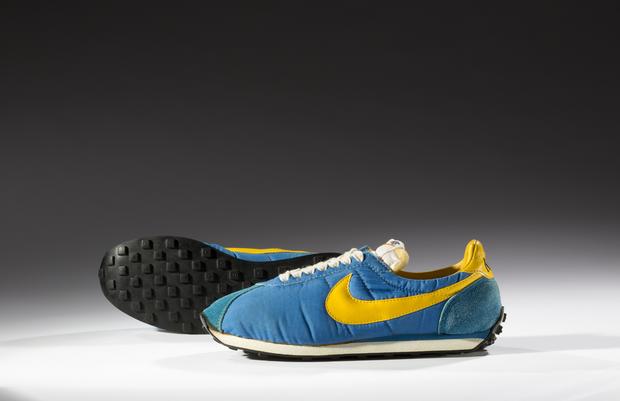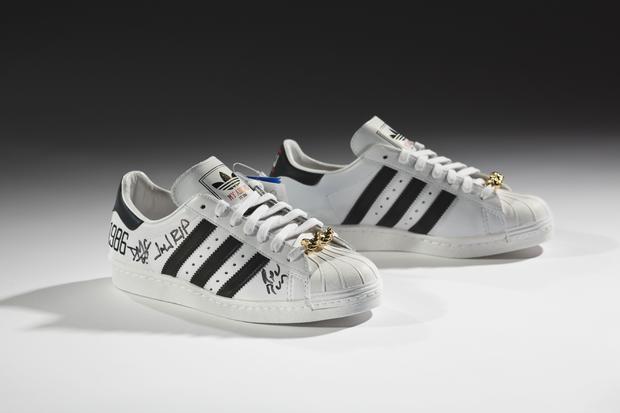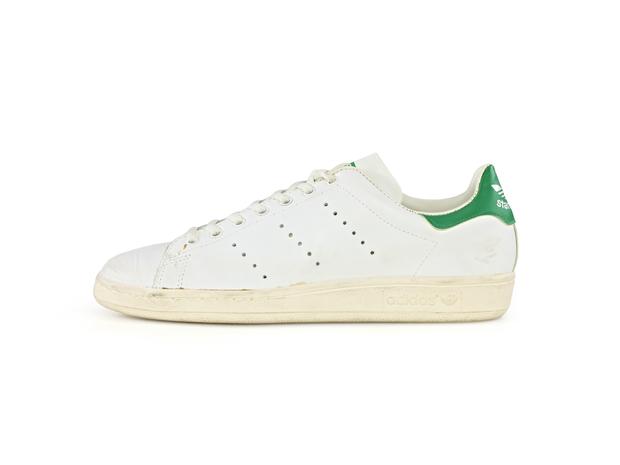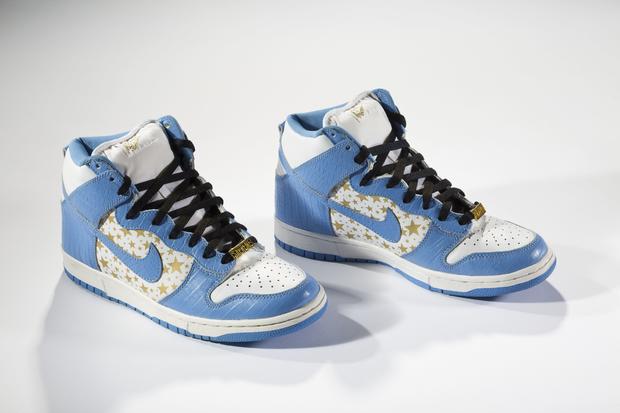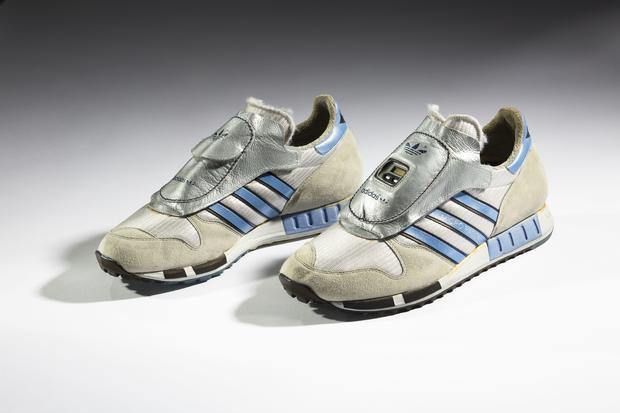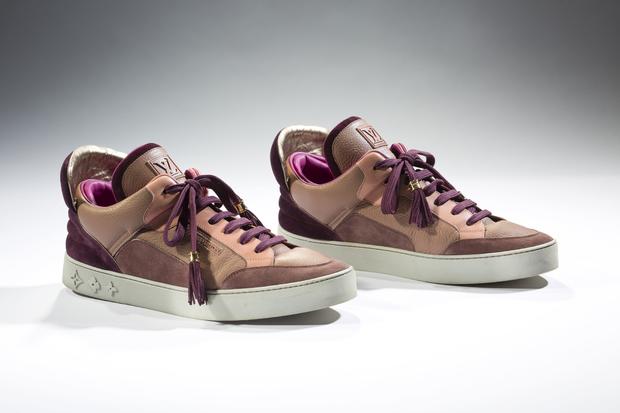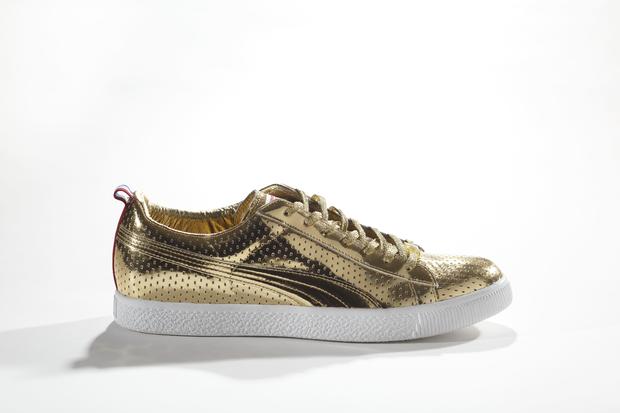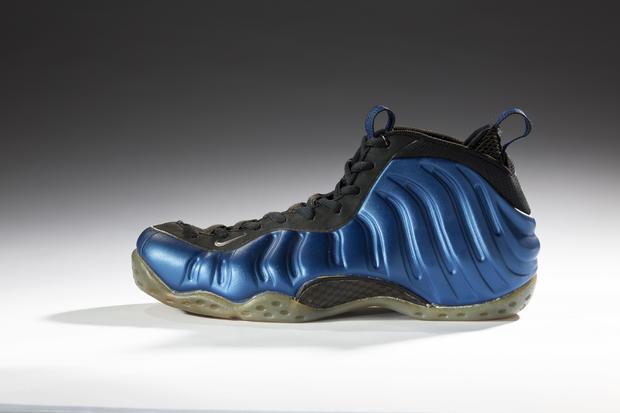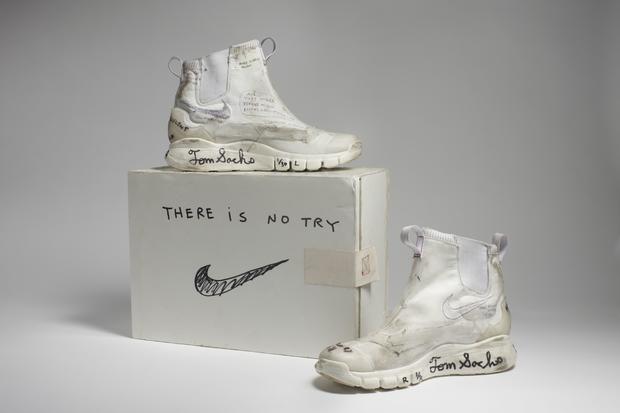The Rise of Sneaker Culture
Have you ever given any thought to the ever present footwear -- sneakers -- and their evolution? Whether you call them sneakers or tennis shoes or basketball shoes they are a global obsession worn by billions and found in every corner of the Earth.
The traveling exhibition, "The Rise of Sneaker Culture," is the first to give this particular shoewear pride of place in the art world; exploring the complex social history and cultural significance of the ever present footwear. The show, which runs at the Brooklyn Museum in New York City through October 4, 2015, will travel to the Toledo Museum of Art in Ohio (from Dec. 3, 2015-February 28, 2016), then to the High Museum of Art in Atlanta (June 12-August 14, 2016), and the Speed Art Museum in Louisville, Ky., (September 5-December 1, 2016).
Fashion designer Pierre Hardy launched his line of footwear for women in 1999 and for men in 2002. Among his many designs are sneakers that play with primary colors and geometric shapes. The design of this pair of limited-edition Poworamas was inspired by the Pop art style of Roy Lichtenstein.
Sneaker culture
There are approximately 150 sneakers in the exhibition from the likes of Adidas, Converse, Nike, Puma, Reebok and Prada ... Yes, Prada ... to tickle the fancy of any sneaker aficionado.
Nike Air Jordan I - "Notorious"
Designed by Peter Moore, the Nike Air Jordan I, Michael Jordan's signature model, made its debut in 1985 and instantly gained iconic status. If you can find a pair of the 85 model in mint condition it could cost you thousands of dollars. The Jordan series has produced 29 styles since the original, but the 85 is the classic.
Nike Air Jordans made Chicago Bulls phenom Michael Jordan the "king of sneakers" and Nike Air Jordans are the basketball shoe. The model was first banned by the NBA in 1985 because it wasn't in synch with NBA color regulations. Jordan was fined $5,000 per game for wearing the shoes. That, of course, gave them instant caché and publicity ... as if shoes worn by Michael Jordan needed any more fanfare.
Running Shoe - 1860-65
A new fashion for "pedestrianism," or competitive walking, emerged in the early 1800s, and by the middle of the century, competitive running had also grown in popularity, with most of its serious participants still wearing leather shoes.
This pair, thought to be the oldest example, resembles men's dress shoes of the period with the exception of the spikes on the soles, which give away their true purpose. The broad band of leather across the instep, added for support, also indicates their use in sport.
Converse All Star - 1917
In 1917, the Converse Rubber Shoe Company debuted its new indoor gym shoe, the All Star. The brown canvas models were marketed as All Stars, while the same shoes in white canvas and with a slightly different tread were called Non Skids. Both featured the brand's signature toe cap, toe bumper, license plate on the heel, and a patch over the inner ankle for protection.
Basketball coach Chuck Taylor joined the company in the early 1920s, both to promote the sneaker and to advise on its design and development; his name was added to the All Star in 1934.
Fleet Foot 1925
As the 20th century began, the prevailing concern about women and their participation in sports was that it would somehow detract from their femininity (one might argue that little has changed). Applying menswear detailing to a woman's high heel shoe in this 1925 shoe with rubber-soles allowed women to play sport, while still conforming to cultural expectations and keeping a lid on the criticism.
Adidas - Modell Waitzer - 1936
Adolf Hitler viewed the 1936 Berlin Olympics as an opportunity to flaunt his theory of Aryan racial superiority through the athletic prowess of German athletes. The astonishing performance of African-American Jesse Owens refuted those views, with Owens winning four gold medals -- the most awarded to any Olympian to that point.
The model, whose merits included anatomic form and elastic construction, bore the name of the German track coach at that time, Jo Waitzer. German shoemaker and future Adidas founder Adi Dassler boldly offered his athletic shoes to Owens through Waitzer, who took great political risk in getting the shoes to the American. Owens wore a bespoke pair of Modell Waitzers at the Olympics. Word got around that the "fastest man alive" scored Olympic gold in shoes made by Dassler, a man few had heard of from a small town in Germany. The rest, as they say, is history.
Converse Gripper
These high tops may look like Converse All Stars, but they are Converse Grippers, a style popular in the late 1940s and early 1950s.
These postwar sneakers were advertised as being made from sturdy army duck cloth, and their heavy, ribbed, white toe guards, ventilating perforations and duck-covered insoles with "comfort-cushioned arches" were designed for playing basketball as well as general sports.
Nike Waffle Trainer 2974
These shoes were literally inspired by waffles ... that's right. Bill Bowerman, the co-founder of Nike, was having breakfast one morning with his wife when he realized the grooves of the waffle iron would make a great mold for shoe bottoms so he could make a good grip without the need for spikes, according the The Atlantic. And thus was born Nike's first sneaker -- the Waffle Trainer -- which debuted in 1974.
25th Anniversary Superstar 2011
In 1986, Run-DMC invited Adidas executives to Madison Square Garden to hear them perform their hit single "My Adidas." Adidas responded by giving the rappers a one million-dollar contract, making them the first non-athletes to receive a sneaker deal.
Run-DMC wore Superstars without laces, a controversial choice as the fashion originated in prisons, where laces were removed as a safety precaution. This autographed pair of Superstars was released November 11, 2011, in honor of the rap single's twenty-fifth anniversary.
Courtesy of Run-DMC, collection of Erik Blam.
Adidas Stan Smith 1980s
In 1971, Adidas approached tennis great Stan Smith with the idea of having him endorse one of its tennis shoes. The Haillet was chosen as the model, and for a brief history in the evolution of the Robert Haillet to the Stan Smith, the sneaker featured two endorsements. Haillet's signature remained on the upper, while Smith's portrait and signature were added to the tongue. By 1978, however, Haillet had retired from tennis, and his name was dropped from the shoe, allowing it to become known simply as the Stan Smith.
Dunk High Pro SB Supreme- 2003
Dunk High Supremes debuted in 2003 as part of the Be True to Your School Nike Dunk campaign. The style, with gold starred gator-print uppers and gold dubrays with the word "SUPREME," was limited to 1,000 pairs for each colorway. The variety and limited number of the Dunk SB line created a sub-culture of dedicated followers, willing to do anything to get the next pair.
1984 Adidas Micropacer
The revolutionary 1984 Adidas Micropacer had a microsensor in the left toe that could record distance, running pace, and caloric consumption. This information was retrieved on the readout screen found on the tongue of the left shoe. The small screen was only one of the sneaker's futuristic aspects; the silver-gilt leather and unusual lace covers also heralded a new era of technology-enhanced athletic performance.
Louis Vuitton x Kanye West Don
There are at least 15 different styles of Kanye West sneakers out there in the world. This 2009 Don Tan/Burgundy Louis Vuitton x Kanye West pair from the celebrity's private collection is one of the more sedate models. A "pre-owned" pair was recently on sale at eBay for $2,500.
Clyde Gametime Gold
The Clyde Gametime Gold shoe, with perforations on the uppers and red, white, and blue heel tabs, was created in homage to the U.S. gold-medal-winning Olympic basketball team. Puma first collaborated with Undefeated, an urban fashion brand and boutique founded in Los Angeles, in 2009, and again in 2011 and 2012.
Achilles Low 2015
The minimally-styled, luxurious Common Projects Achilles Low is a fan favorite and the first model created by the brand.
The plain white low-top sneaker has old-school chic for those who appreciate the minimalist approach to sneakers and life.
Nike Air Foamposite 1997
The original Nike Air Foamposite One was another one of Nike's shoes to exhibit innovation with a liquid cast-mold on a solid rubber sole in a startling, distinct design.
It was a model not entirely appreciated at the time either because of its high price or looks, disappearing off shelves for ten years and the original mold destroyed.
NikeCraft Lunar Underboot
American artist Tom Sachs creates works that engage issues surrounding the fetishization of branding. He is a proponent of the concept of bricolage, or makeshift handiwork constructed out of materials at hand. As part of his collaboration with Nike, called NikeCraft, the moon boot was a prototype.
The manufactured sneakers, which retain a handcrafted feeling, are made with Nike Special Forces outsoles and Vectran fabric from the airbags on the Mars Excursion Rover. Rather than designing shoes with athletes in mind, Sachs stated that "these shoes are built to support the bodies of the strongest minds in the aerospace industry."
NikeCraft Lunar Underboot Aeroply Experimentation Research Boot Prototype, 2008-12.
The Rise of Sneaker Culture
The book, "Out of the Box: The Rise of Sneaker Culture," written by Bobbito Garcia and Elizabeth Semmelhack catalogs the exhibition and also highlights prototype drawings that span the career of Nike sneaker design legend Tinker Hatfield, making it an interesting illustrated history of sneaker culture.
